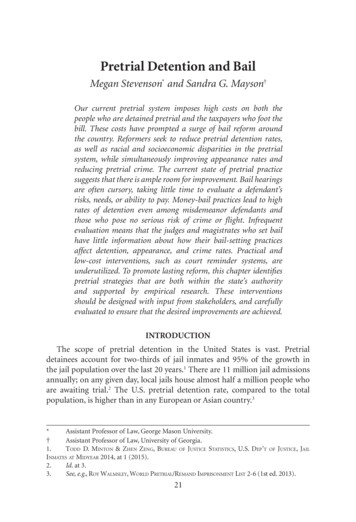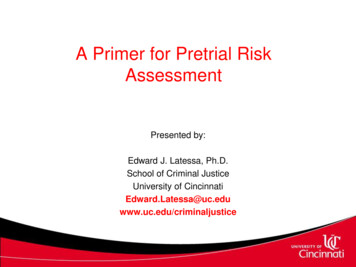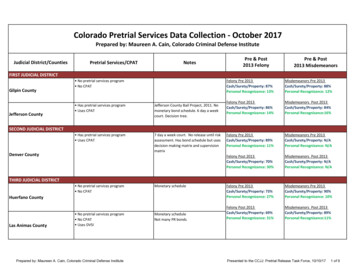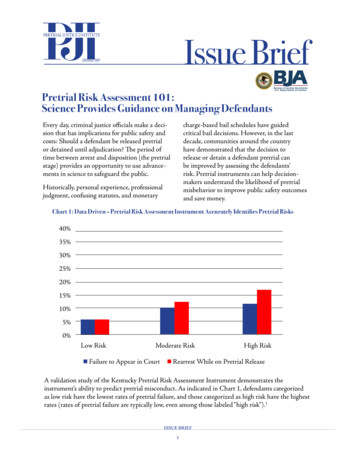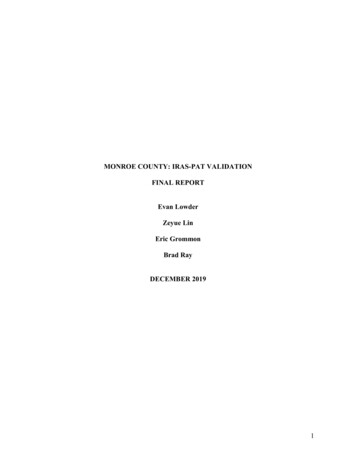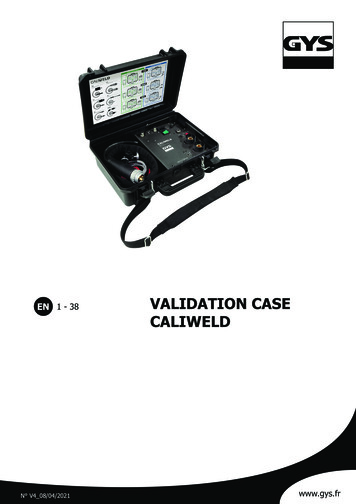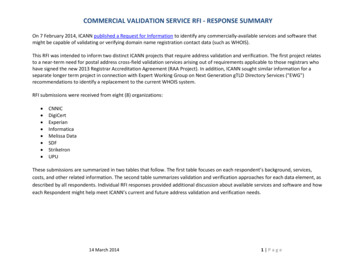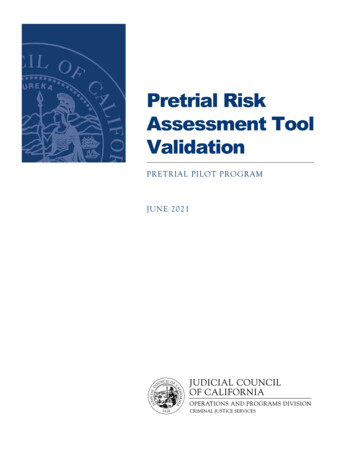
Transcription
Pretrial RiskAssessment ToolValidationPRETRIAL PILOT PROGRAMJUNE 2021
CONTENTSExecutive Summary. 1Introduction . 3Legislative Mandate . 3Validation Methods . 4Definitions . 5Validation Sample Sizes . 5Data Description and Limitations . 5Data Sources . 6Date Range . 6Data Linking and Filtering . 7Descriptive Statistics . 8Pretrial Tools . 8Demographics. 9Arrest Offenses . 9Adverse Outcomes . 10Conditions OF Monitoring/Supervision . 11PSA Validation . 11General Validation . 11Analysis of Predictive Bias . 15Race/Ethnicity . 15Gender . 22VPRAI Validation . 27General Validation . 27Analysis of Predictive Bias . 30Race/Ethnicity . 30Gender . 35VPRAI-R Validation . 41General Validation . 41Analysis of Predictive Bias . 44Race/Ethnicity . 44Gender . 44ORAS Validation . 46General Validation . 46Analysis of Predictive Bias . 49Race/Ethnicity . 49Gender . 49VPRAI-O Validation . 50Appendix A. PSA Violent Offense List . 51Appendix B. . 56
EXECUTIVE SUMMARYThis report fulfills the legislative mandates of the Budget Act of 2019 (Assem. Bill 74; Stats. 2019, ch. 23),and Senate Bill 36 (Stats. 2019, ch. 589). SB 36 requires each pretrial services agency that uses a pretrialrisk assessment tool, including the Pretrial Pilot Projects, to validate the risk assessment tool used by theprogram by July 1, 2021, and to make specified information regarding the tool, including validationstudies, publicly available. The Judicial Council is required to maintain a list of pretrial services agenciesthat have satisfied those validation requirements and complied with those transparency requirements.AB 74 also provided funding to the Judicial Council to assist the pretrial pilot courts in validating theirrisk assessment tools.In response to the requirements of AB 74 and SB 36, the Judicial Council of California conducted thefollowing validation studies for four pretrial risk assessment tools. The period for this validation extendsfrom October 1, 2019 – December 31, 2020 and includes a diverse sample of counties in California.Among the counties, population size ranges from less than 10 thousand to over 10 million, geographicregions range North to South as well as inland and coastal. Demographically, the counties representboth majority Hispanic and Non-Hispanic White populations.The Judicial Council conducted pretrial risk assessment validation studies for: Ohio Risk Assessment System Pretrial Assessment Tool (ORAS-PAT), developed by theUniversity of Cincinnati, Center for Criminal Justice Research - used by the Pretrial Pilot Projectsin Modoc, Napa, Nevada/Sierra, Ventura, and Yuba counties. Public Safety Assessment (PSA), developed by Arnold Ventures - used by the Pretrial PilotProjects in Calaveras, Los Angeles, Sacramento, Sonoma, and Tuolumne counties. Virginia Pretrial Risk Assessment Instrument (VPRAI), developed by the Virginia Department ofCriminal Justice Services - used by the Pretrial Pilot Projects in San Joaquin and Santa Barbaracounties. Variations of the VPRAI (VPRAI-R and VPRAI-O) - used by the Pretrial Pilot Projects in Alameda,Kings, San Mateo, and Santa Barbara counties.This report includes the following validation studies:oOverall validations for the PSA and VPRAI tools, and a study of predictive validity of the tools byrace/ethnicity and gender.oOverall validations for the ORAS and VPRAI-R tools.If larger sample sizes become available, the Judicial Council will conduct a validation study for the VPRAIO risk assessment tool, and test the predictive validity of the ORAS, VPRAI-R and VPRAI-O tools byrace/ethnicity and gender.The risk scores presented in this report are calculated using a scoring scheme designed by tooldevelopers. The tools take into account aspects of an individual’s criminal history, current criminaloffense, history of failures to appear in court, age, and other factors depending on the tool (see
Pretrial Pilot ProgramTool Validationappendix X for the factors and weights specific to each tool). Gender and race are not used in any of thetools to calculate risk scores.In conducting the validations, the Judicial Council used the Area Under the Curve (AUC) and logisticregression to examine the tools’ accuracy and reliability. The AUC value is a single number thatrepresents the ability of the tool to differentiate between individuals who are lower or higher risk acrossthe range of the tool. The AUC is calculated for each tool overall and, when the sample size is sufficient,separately for each gender and race/ethnicity group to examine whether the ability of the tool todifferentiate individuals by risk differs by gender or race/ethnicity. Logistic regression is used to testwhether risk scores statistically significantly predict the likelihood of each outcome of interest (failure toappear; new arrest; new filing; new conviction; new violent arrest; and a composite measure of FTA ornew arrest), and whether any differences in outcomes by risk level across gender or race/ethnicity arestatistically significant. Statistical significance is a technical term used in analyses to indicate that it isvery unlikely that a result or difference occurred by chance. Statistical significance does not necessarilyindicate the size of the result or difference.In the validation studies conducted by the Judicial Council, using a common metric for interpreting AUCvalues in criminal justice risk assessments, all tools have a AUCs in the good to excellent ranges fornearly all measured outcomes, both overall and for all of the race/ethnicity and gender subgroupsanalyzed, and AUCs in the fair range in a limited number of categories.Results of the regression analyses show that the association between risk score and all outcomes ofinterest was statistically significant. When analyzed by race, ethnicity and gender, some statisticallysignificant differences were found in both the PSA and VPRAI in most outcomes. Further research isneeded to analyze the elements that may be driving the observed differences and whether there aredata-driven modifications to the tools’ risk factors or weights that can further improve the predictivepower of the tools.This report solely analyzes risk scores and associated outcomes for individuals who were releasedpretrial. Individuals may have been released by the Sheriff, by a judge, or on bail. This report does notlook at judicial decision-making or judges’ use of the tools.We would like to thank the courts and their justice partners in the pilot counties for their participation inthese validation studies.2
Pretrial Pilot ProgramTool ValidationINTRODUCTIONLEGISLATIVE MANDATEThis report fulfills the legislative mandates of the Budget Act of 2019 (Assem. Bill 74; Stats. 2019, ch. 23),and Senate Bill 36 (Stats. 2019, ch. 589). In AB 74, the Legislature directed the Judicial Council toadminister two-year pretrial projects in the trial courts. The goals of the Pretrial Pilot Program, as set bythe Legislature, are to: Increase the safe and efficient prearraignment and pretrial release of individuals booked intojail;Implement monitoring practices with the least restrictive interventions necessary to enhancepublic safety and return to court;Expand the use and validation of pretrial risk assessment tools that make their factors, weights,and studies publicly available; andAssess any disparate impact or bias that may result from the implementation of these programs.Sixteen Pretrial Pilot Projects (17 courts) were selected to participate in the program. 1SB 36 requires each pretrial services agency that uses a pretrial risk assessment tool, including thePretrial Pilot Projects, to validate the risk assessment tool used by the program by July 1, 2021, and on aregular basis thereafter, and to make specified information regarding the tool, including validationstudies, publicly available. The Judicial Council is required to maintain a list of pretrial services agenciesthat have satisfied those validation requirements and complied with those transparency requirements.The Judicial Council is also required to publish a report on the judicial branch’s public website with datarelated to outcomes and potential biases in pretrial release.AB 74 provided funding to the Judicial Council “for costs associated with implementing and evaluatingthese programs, including, but not limited to: [¶] .(e) Assisting the pilot courts in validating their riskassessment tools.” This report, in accordance with AB 74 and SB 36, provides information on thevalidation of the pretrial risk assessment tools used by the 17 Pretrial Pilot courts.Pretrial risk assessment tools use actuarial algorithms to assess the likelihood that a person who hasbeen arrested for an offense will fail to appear in court as required or will commit a new offense duringthe pretrial period. The pretrial risk assessment tools used by the 16 Pretrial Pilot Projects are: ORAS (Ohio Risk Assessment System; developed by the University of Cincinnati, Center forCriminal Justice Research)PSA (Public Safety Assessment; developed by the Laura and John Arnold Foundation)The pilot counties are Alameda, Calaveras, Kings, Los Angeles, Modoc, Napa, Nevada, Sacramento, San Joaquin,San Mateo, Santa Barbara, Sierra, Sonoma, Tulare, Tuolumne, Ventura, and Yuba Counties. Nevada and SierraCounties participated as a consortium.13
Pretrial Pilot Program Tool ValidationVPRAI (the Virginia Pretrial Risk Assessment Instrument, developed by the Virginia Departmentof Criminal Justice Services)VPRAI-R and VPRAI-O (variations of the VPRAI)SB 36 requires pretrial risk assessment tools to be validated. SB 36 defines “validate” as follows:“Validate” means using scientifically accepted methods to measure both of thefollowing:(A) The accuracy and reliability of the risk assessment tool in assessing (i) the risk that anassessed person will fail to appear in court as required and (ii) the risk to public safetydue to the commission of a new criminal offense if the person is released before theadjudication of the current criminal offense for which they have been charged.(B) Any disparate effect or bias in the risk assessment tool based on gender, race, orethnicity.(Sen. Bill 36, § 1320.35(b)(4).)VALIDATION METHODSThe following methodology has been used to validate each of the pretrial risk assessment tools used byPretrial Pilot Projects for which data were sufficient.Descriptive statistics are presented, exploring basic features of the data such as demographics, andshowing the overall distributions of arrest offenses and adverse outcomes. The distributions of riskscores are shown in groupings of risk level defined by each tool developer.A receiver operating characteristic (ROC) curve model has been used to provide the area under thecurve (AUC) statistic for each outcome of interest. The outcomes of interest are: Failure to appear (FTA)New arrestNew filingNew convictionNew violent arrestFTA or new arrest (composite measure)The AUC statistic is a single number that summarizes the overall discriminative ability of the tool.The observed rate of adverse outcomes at each score is presented. The pattern of these rates is anindicator of the accuracy of the tool, showing whether risk scores predict monotonic increasing failurerates for each outcome of interest.Logistic regression has been used to test whether risk scores are statistically significant predictors of thelikelihood of each outcome of interest.4
Pretrial Pilot ProgramTool ValidationThe AUC has been calculated separately for each gender and race/ethnicity group to examine whetherthe discriminative ability of the tool differs by gender or race/ethnicity. To measure any predictive biasin the tools, fitted curves of the rates of adverse outcomes at each score are shown separately bygender and race/ethnicity groups. Logistic regression has been used to test whether the likelihood ofeach outcome of interest by risk level differs statistically across gender or race/ethnicity groups.DEFINITIONS-Pretrial period is the time period starting at booking of an individual at the jail and ending atresolution of any and all cases associated with that booking.-Failure to appear (FTA) is measured using court records documenting issuance of a benchwarrant for FTA during the pretrial period.-New arrest 2 is any new arrest during the pretrial period reported to the California Departmentof Justice ( CA DOJ).-New filing is any new arrest, during the pretrial period, that results in charges filed with thecourt and reported to the CA DOJ. 3-New conviction is any new arrest during the pretrial period that results in a conviction reportedto the DOJ during the data collection period. 4-New violent arrest is any new arrest during the pretrial period for an offense on the PretrialPilot consensus PSA Violent Offense List, which includes felonies and misdemeanors of a violentnature. For the full list of offenses, see Appendix A.-FTA or new arrest is a combined measure indicating an occurrence of an FTA, a new arrest, orboth. This measure is shown for the ORAS, VPRAI, and VPRAI-R which were designed to predictoverall “pretrial failure.” This measure is not shown for the PSA because it was designed topredict outcomes separately.VALIDATION SAMPLE SIZESFor purposes of this report, general validation results are shown when the sample size was greater than200. For analyses of predictive bias by race/ethnicity and gender, subgroup results are shown when theoverall sample was at least 1,000 and each subgroup size was greater than 200. Sample sizes smallerthan these may not produce reliable results.DATA DESCRIPTION AND LIMITATIONSThe data set for the pretrial risk assessment tool validations was created using data from the court andtwo agencies in each of the Pretrial Pilot Program counties, as well as statewide data from the CaliforniaNew criminal offenses are defined in four ways to capture different outcomes of interest. All new criminaloffense indicators are measured using data from the California Department of Justice (CA DOJ).2CA DOJ records on arrests are likely more complete than CA DOJ records on court filings and dispositions. Courtreporting to the CA DOJ is incomplete.3Because of the short time frame of the data collection period and delays in court reporting to the DOJ, newconvictions may not be a complete measure of all arrests, during the pretrial period, that result in a conviction.45
Pretrial Pilot ProgramTool ValidationDepartment of Justice. Although the number of assessed bookings during this period totaled 134,253,the evaluation data set used in this validation tracks the records of 23,353 bookings with associatedpretrial risk assessments and completed pretrial periods; assessed bookings without completed pretrialperiods or for which the individual was not released pretrial are not included in the evaluation data set.The risk scores presented in this report are calculated using a scoring scheme designed by tooldevelopers. The tools take into account aspects of an individual’s criminal history, current criminaloffense, history of failures to appear in court, and other factors depending on the tool (see Appendix Afor the factors and weights specific to each tool). Gender and race are not used in any of the tools tocalculate risk scores.This report solely analyzes risk scores and associated outcomes for individuals who were releasedpretrial. Individuals may have been released by the Sheriff, by a judge, or on bail. This report does notlook at judicial decision-making or judges’ use of the tools.DATA SOURCES Jail booking data: County sheriffs’ offices provided information on all individuals booked intolocal county jails, including booking dates, charges, and releases. Probation data: County probation departments performed pretrial assessment services andprovided pretrial risk assessment information, including assessment dates, scores, andrecommendations for those assessed. Court case data: Superior courts provided court case information, including pretrial dispositiondates and the issuance of warrants for failures to appear for individuals people with felony ormisdemeanor criminal filings. California Department of Justice Data: CA DOJ provided arrest and disposition data, includingout-of-county filings, for booked defendants.DATE RANGEThe time period for this validation extends from October 1, 2019 to December 31, 2020, for mostcounties. 5 October 1, 2019, marks the beginning of the Pretrial Pilot Program grant period.5See Appendix B for date range for each county.6
Pretrial Pilot ProgramTool ValidationTable 1. Assessment Date Ranges, by ToolDATA LINKING AND FILTERINGAfter data were collected from each source, they were standardized and linked together to create avalidation data set of bookings with associated pretrial risk assessment information, relevant court caseinformation, and outcomes during the pretrial period. In most counties, local justice agencies keepseparate data systems, and not all data were able to be matched across agencies. The only bookingsincluded in the validation data set were those for which the individual was released pretrial and therewas a final disposition associated with the booking because outcomes during the pretrial period were aprimary interest of this analysis and also so that the full pretrial period could be observed. This reportrefers to each booking linked with an associated assessment and completed pretrial period as a “pretrialobservation.”The tables below show the number of assessments for each tool and county at each stage of filtering,and the type of validation that will be presented based on the sample size. It is anticipated thatvalidation of all tools and for all counties will be completed when sample sizes reach the thresholdsdescribed under Validation Sample Sizes, above. 6The number of assessments performed during the evaluation period ranged from a low of 691assessments for the VPRAI-O (Kings County) to a high of 92,791 assessments for the PSA (Calaveras, LosAngeles, Sacramento, Sonoma, and Tuolumne Counties). The next column represents assessmentslinked to unique jail bookings, ranging from a low of 250 for the VPRAI-O to a high of 80,800 for the PSA.The next column shows the number of bookings with associated pretrial risk assessments that have afinal disposition. Linking bookings with pretrial risk assessments and selecting only cases with a finaldisposition lowers the sample to a range of 41–34,270 observations. Because of the limited time periodfor the evaluation, this drop in observations is expected. 7 The next column shows the evaluation sampleof bookings with associated pretrial risk assessments that have a final disposition, and in which thedefendant was released pretrial. The evaluation samples range from 14 to 14,849 pretrial observations.A large portion of the time frame for the evaluation data set overlapped with the COVID-19 pandemic,which likely had large impacts on crime, policing and booking practices, and the ability of courts toprocess cases, likely lowering the number of cases with a final disposition during this time frame.Santa Barbara switched from the VPRAI to the VPRAI-R during the pilot period. Data will be used in the pilotwidetool validation of both tools, but Santa Barbara County–level validation will be performed only for the VPRAI-Rbecause the VPRAI is no longer in use in Santa Barbara.6The VPRAI tool experiences a smaller relative drop in observations because of the longer time frame of the VPRAIassessments (see Table 1 for date ranges for each tool).77
Pretrial Pilot ProgramTool ValidationBecause the sample size for the VPRAI-O was smaller than the designated minimum sample size of 200for general validation, it was not possible to validate the VPRAI-O risk assessment tool in the currentvalidation study.Table 2: Counts of All Assessments at Each Stage of Filtration for Evaluation Sample, by ToolTable 3: Counts of All Assessments at Each Stage of Filtration for Evaluation Sample, by CountyCountyTool NameAlamedaCalaverasKingsLos AngelesModocNapaNevada/SierraSacramentoSan JoaquinSan MateoSanta BarbaraSanta SAssessments AssessedBookingsPretrialCompleteReleasedValidation 121,3036,71516526524721817725General OnlySample Too SmallSample Too SmallGeneral BiasSample Too SmallSample Too SmallSample Too SmallGeneral BiasGeneral BiasSample Too SmallNo longer in useGeneral OnlyGeneral OnlySample Too SmallGeneral Only28412312349Sample Too SmallDESCRIPTIVE STATISTICSPRETRIAL TOOLSThis report addresses the validation of four pretrial risk assessment tools: Ohio Risk Assessment System–Pretrial Assessment Tool (ORAS-PAT), Public Safety Assessment (PSA), Virginia Pretrial Risk AssessmentInstrument (VPRAI), and Virginia Pretrial Risk Assessment Instrument–Revised (VPRAI-R). The PretrialPilot Program counties using each of these tools and included in the evaluation data set are listed inTable 4.8
Pretrial Pilot ProgramTool ValidationTable 4. Counties Contributing Assessment Data for Each Assessment ToolDEMOGRAPHICSThe pretrial programs evaluated in this validation come from a diverse sample of counties in California.Among the counties, population sizes range from less than 10,000 to over 10 million, and geographicregions range north to south as well as inland and coastal. Demographically, the counties represent bothmajority Hispanic and non-Hispanic white populations.Additionally, there are broad differences in the racial and ethnic makeup of the assessed populations ineach county. For each pretrial risk assessment tool used, Table 5 provides the number of assessments inthe evaluation data set, the racial/ethnic and gender makeup, and the median age. The proportions ofeach race and ethnicity vary widely across tools (6–27% Black, 40–56% Hispanic, and 19–36% white),gender 8 proportions vary moderately (14–23% female), and median age varies slightly (30–34 years).This pattern of variation across counties in criminal justice–involved populations is typical. 9Table 5. Demographic Profile of Evaluation Data Set, by ToolARREST OFFENSESThe arrest offenses leading to the bookings in the evaluation data set varied across counties. Felonyarrests represented the majority of bookings (57–81%); misdemeanor arrests were a smaller share (19–8Nonbinary, other, and unknown genders represented less than 0.1% of the bookings in the evaluation data set.See ; ifornia/.99
Pretrial Pilot ProgramTool Validation43%). Violent offenses 10 represented 20–37% of bookings in the data set; property offenses were 21–23% and drug offenses 14–29% of bookings in the data set. Driving under the influence (DUI) offensesranged from 5% to 14% of bookings, and domestic violence (DV) offenses made up 15–35% of bookingsin the evaluation data set.Table 6. Distribution of Arrest Offense Type, by Tool (numbers shown in percentages)ADVERSE OUTCOMESSeveral different adverse outcomes are measured during the pretrial period from pretrial release todisposition. Failure to Appear (FTA), measured as bench warrants issued for FTA during the pretrialperiod, ranged from 9.7–36.5% of pretrial observations. New arrests during the pretrial period rangedfrom 31.6–38.2% of pretrial observations. New arrests during the pretrial period resulting in filedcharges were recorded for 12.4–18.4% of pretrial observations, and new arrests during the pretrialperiod resulting in convictions were recorded for 8.8–11.7% of pretrial observations. 11 New violentarrests 12 (including felony and misdemeanor arrests for offenses of a violent nature) were recordedduring the pretrial period for 8.8–11.2% of pretrial observations.Table 7. Rates of Pretrial Misconduct, by ToolViolent offenses, as defined by the pilot consensus PSA Violent Offense List (see Appendix A). These offensesinclude both felonies and misdemeanors that are violent in nature.10New arrest, new filing, and new conviction data are measured using CA DOJ data. New arrests and new violentarrests are reported to the CA DOJ from arresting agencies, whereas new filings and new convictions are reportedto the CA DOJ from courts. The DOJ may have incomplete records of filings and convictions from the courtsbecause of difficulties or delays in reporting, an
The Judicial Council conducted pretrial risk assessment validation studies for: Ohio Risk Assessment System Pretrial Assessment Tool (ORAS-PAT), developed by the University of Cincinnati, Center for Criminal Justice Re search - used by the Pretrial Pilot Projects in Modoc, Napa, Nevada/Sierra, Ventura, and Yuba counties.
